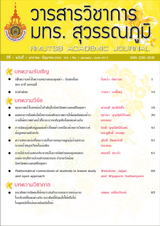คุณภาพน้ำในแหล่งน้ำสำคัญในจังหวัดพระนครศรีอยุธยา
Main Article Content
Abstract
Water quality in the major water resource in Phra Nakhon Si Ayutthaya province
The structural transformation of the economy from agriculture to industry of Phra Nakhon Si Ayutthaya province has resulted in a rapid increase in population and the water quality deterioration both in the urban and the industrial areas. The aim of this research was to study the water quality in the main rivers: the Chao Praya River, the Lopburi River, and the Pa Sak River around the provincial city island. The study areas were divided into three parts: the upstream – the part of the rivers from the north before coming through the island, and the part around the island; and the downstream – the part of the rivers flowing out of the province. Each month, eleven water parameters from 8 sampling points were collected from November 2008 to October 2009. It was found that the variation of different parameters was as follows. Temperature: 24.1 – 31.8 oC; Conductivity: 120 – 427 μS.cm-1; Suspended Solid (SS) : 9 – 55 mg/l; pH: 6.6 – 7.8; Dissolved Oxygen (DO) : 2.2 - 6.72 mg/l ; BOD: 0.6 – 5.1 mg/l; Nitrate (NO3) : 0.08 - 0.46 mg/l; Phosphate (PO4) : 0.01 – 0.12 mg/l; Total Solid (TS) : 168 - 321 mg/l; Total Bacteria Count (TBC) : 2,300 - 54,000 MPN/100 ml; and Fecal Bacteria Count (FBC) : 200 - 19,000 MPN/100 ml; The Water Quality Index (WQI) calculated from those parameters was 64.17 - 86.77. In conclusion, the water quality in the three main rivers was based on the standard of surface water of the 2 – 4 types. This water quality information is useful for surveillance and monitoring, as well as its use in the management of water resources for sustainability.
Article Details
Published manuscript are the rights of their original owners and RMUTSB Academic Journal. The manuscript content belongs to the authors' idea, it is not the opinion of the journal's committee and not the responsibility of Rajamangala University of Technology Suvarnabhumi


